170. Western Osprey Pandion haliaetus (Visvalk)
Order: Accipitriformes. Family: Pandionidae
The Osprey (or fishhawk) is a fish-eating hawk in its own family (Pandionidae) that is found almost everywhere in the world. It possesses specialised physical characteristics and exhibits unique behaviour to assist in hunting and catching prey. As a result of these unique characteristics, it has been given its own taxonomic genus, Pandion and family, Pandionidae. Four subspecies are usually recognized, one of which has recently been given full species status (P. h. cristatus as Eastern Osprey). Its toes are of equal length, its tarsi are reticulate, and its talons are rounded, rather than grooved. The Osprey and owls are the only raptors whose outer toe is reversible, allowing them to grasp their prey with two toes in front and two behind. This is particularly helpful when they grab slippery fish.
Description
The plumage of the osprey is generally brown above and white below, with a whitish head. The wings are long and pointed and the legs are stout and heavily scaled. It has yellow-eyes with a dark band through the eye. Slightly crested head, masked appearance and white underparts identify this large hawk at rest. Seen in flight from below the Osprey has white or slightly mottled underparts. The long wings are angled, bending at the 'wrist' which has a black patch contrasting with the white wing linings, and at a distance it could be mistaken for a large gull.
The juvenile is fairly similar to the adult but the head is more darkly-streaked and the upperparts appear scaled with cream and pale rufous. Juveniles also have an orange-red iris, rather than the yellow iris that is typical of adults. Juvenile plumage is replaced by adult plumage by 18 months of age.
Might be confused with immature African Fish Eagle found in similar habitat, but the latter is a larger bird with broad wings and a very short tail.
Distribution
One of the most widespread birds of prey, it occurs on every continent except Antarctica; in Africa it is partly resident in the tropics but is a non-breeding visitor pretty much everywhere else, including southern Africa. Here it is generally uncommon and localised across much of the region, excluding the arid interior.
Habitat
Mostly freshwater and estuaries, rarely at sea.
Movements and migrations
Mainly a non-breeding migrant to southern Africa, arriving from October-December and leaving from March-May. However there are records of individuals who have stayed in the region over winter and some may even be resident.
Subspecies
There are four subspecies of the osprey, each occupying a different part of its overall range and differing slightly in size and appearance: Pandion haliaetus haliaetus, P. h. carolinensis, P. h. cristatus and P. h. ridgwayi. Pandion haliaetus haliaetus breeds in Europe, Asia and north Africa and winters in South Africa, India and southeast Asia; P. h. carolinensis breeds in North America and the Caribbean and winters in Florida, the Caribbean and South America; P. h. cristatus is a year round resident of coastal Australia and the southwest Pacific; and P. h. ridgwayi inhabits the Caribbean, from Cuba and the Bahamas to southeast Mexico and Belize.
Diet
It almost exclusively eats fish, typically hunting by flying in circles over the water. Once it has spotted a fish it dives into the water feet first, with its wings held back, sometimes submerging itself completely to catch prey up to about a metre below the surface. It is more successful when the water is choppy than when it is calm, probably because prey can spot the Osprey more easily. If it catches a fish, it rises from the water with wings flapping hard to gain height, shivering and shaking itself dry before heading back to a favoured perch to feed.
Breeding
There are only four confirmed breeding records in southern Africa. It is a monogamous, territorial solitary nester. The nest is built by both sexes, consisting of a large, tower-like platform of sticks and other woody material, up to 1.5 m high and 1 m wide. A cup is set into the top of the structure, lined with dry grass. It can be placed in a variety of sites; in southern Africa it was once found in a Sycamore fig (Ficus sycomorus). Egg-laying season is in spring and summer. It lays 1-4 eggs, which are incubated for about 35-43 days. The chicks stay in the nest for roughly 50 days.
Call
Usually silent. Listen to Bird Call.
Status
Uncommon non-breeding summer visitor to most of South Africa except in the arid west. Classified as Least Concern (LC) on the IUCN Red List.
Africa Wild Bird Book
-
Michele Nel
- Posts: 1912
- Joined: Mon Sep 10, 2012 10:19 am
- Country: South Africa
- Location: Cape Town
- Contact:
-
Michele Nel
- Posts: 1912
- Joined: Mon Sep 10, 2012 10:19 am
- Country: South Africa
- Location: Cape Town
- Contact:
Western Osprey Photos
170. Western Osprey Pandion haliaetus
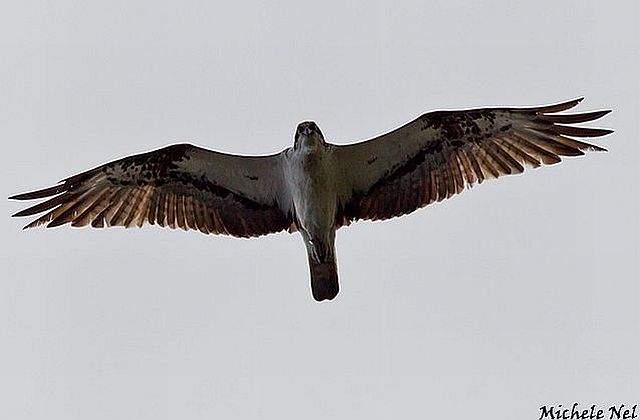 © Michele Nel
© Michele Nel
 © flying cheetah
© flying cheetah
Northern Kruger National Park
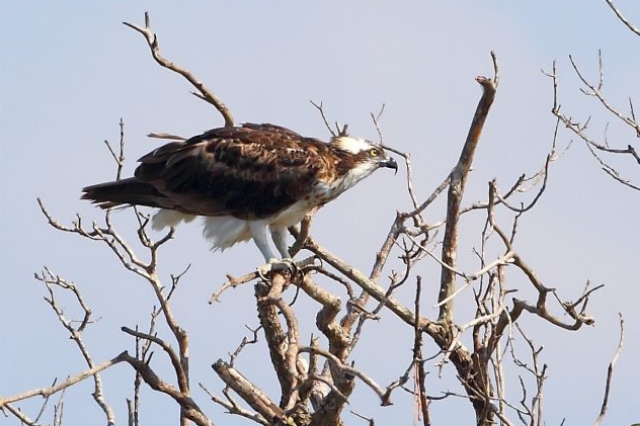 © Duke
© Duke
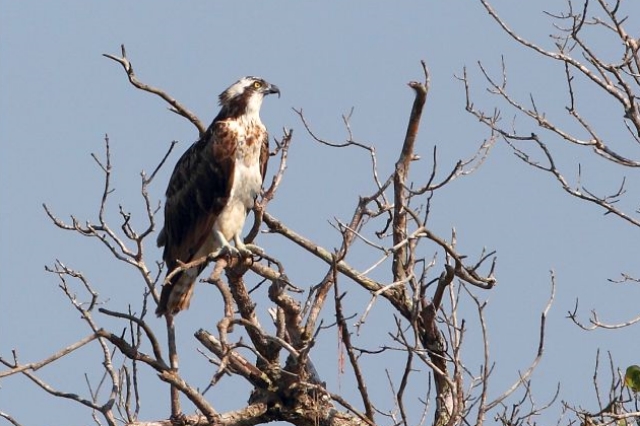 © Duke
© Duke
iSimangaliso, KwaZulu-Natal
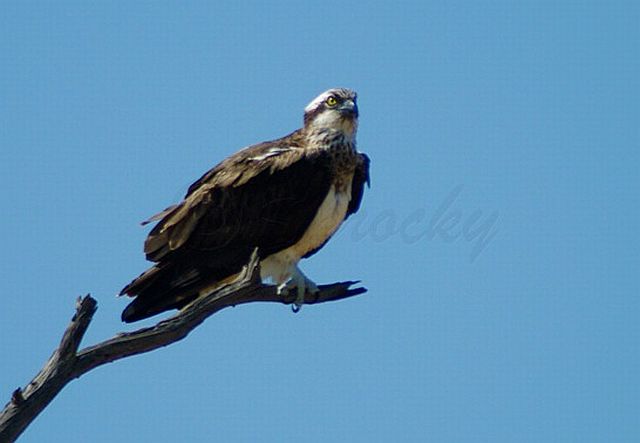 © Sprocky
© Sprocky
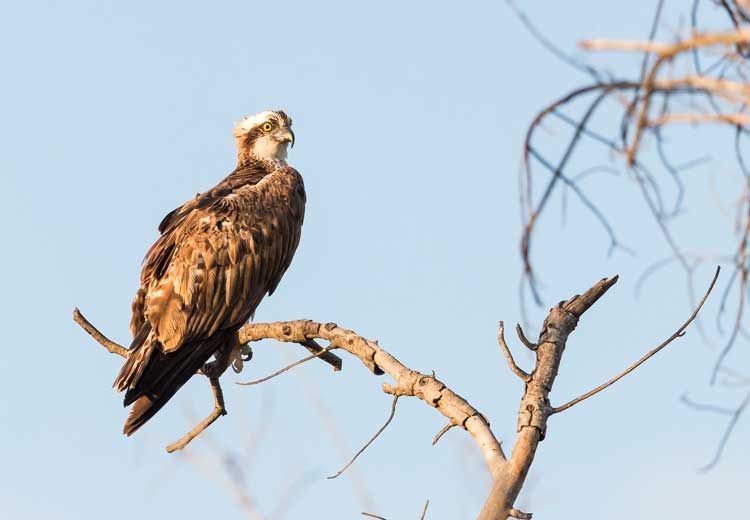 © Pumbaa
© Pumbaa
Kruger National Park, Mphongolo loop
Links:
Species text in The Atlas of Southern African Birds: http://sabap2.adu.org.za/docs/sabap1/170.pdf
Sabap2: http://sabap2.adu.org.za/spp_summary.ph ... §ion=3
Global Raptor Information Network
ARKive: http://www.arkive.org/osprey/pandion-ha ... rtletV3api
Animal Diversity Web: http://animaldiversity.ummz.umich.edu/s ... aetus.html
A very good osprey video. There are 3 sequences in this one video: 1st sequence he catches half a dozen fish in one strike. 2nd sequence he plunges talons into deep water right to the bottom to grab his prey. 3rd sequence he captures a big old fish that looks as if it weighs more than he does!
Submitted by Richprins
 © Michele Nel
© Michele Nel © flying cheetah
© flying cheetahNorthern Kruger National Park
 © Duke
© Duke © Duke
© DukeiSimangaliso, KwaZulu-Natal
 © Sprocky
© Sprocky © Pumbaa
© PumbaaKruger National Park, Mphongolo loop
Links:
Species text in The Atlas of Southern African Birds: http://sabap2.adu.org.za/docs/sabap1/170.pdf
Sabap2: http://sabap2.adu.org.za/spp_summary.ph ... §ion=3
Global Raptor Information Network
ARKive: http://www.arkive.org/osprey/pandion-ha ... rtletV3api
Animal Diversity Web: http://animaldiversity.ummz.umich.edu/s ... aetus.html
A very good osprey video. There are 3 sequences in this one video: 1st sequence he catches half a dozen fish in one strike. 2nd sequence he plunges talons into deep water right to the bottom to grab his prey. 3rd sequence he captures a big old fish that looks as if it weighs more than he does!
Submitted by Richprins
Black-winged Kite
127. Black-winged Kite (formerly known as Black-shouldered Kite) Elanus caeruleus (Blouvalk)
Order: Accipitriformes. Family: Accipitridae
Description
33 cm. A small, easily identified, grey-and-white raptor with diagnostic black shoulder patches. Upperparts blue-grey, Wings broad and pointed with black wing tips. Pale bluish-grey short, square tail. Underparts white, white head with black mask and red eyes. Sexes alike.
It has a characteristic habit of hovering and, when perched, often wags its white tail up and dows.
Immature: As adult, but with yellow-orange eyes; some retain juv remiges, rectrices, greater coverts and alula feathers.
Juvenile: Similar to adult, but breast and neck washed chestnut, nape streaked white. Upper part feathers darker, pale-fringed, appearing scalloped. Flight feathers and coverts dark grey, edged buff; shoulder patch smaller, speckled white. Eyes dark grey-brown, become yellow within 3-4 weeks.
Similar species: At a distance, smaller Dickinson's Kestrel has same pale-headed, grey-backed appearance, but has more slender and elongated silhouette, with barred, not plain tail extending beyond folded wing tips.
Distribution
Occurs in India, South-East Asia, south-western Europe and across sub-Saharan Africa, from southern Mauritania to Eritrea south to southern Africa. Here it is very common across the region, especially in South Africa, north-eastern Zimbabwe and central Botswana.
Habitat
A wide range of open habitats, but most common in grassland, transformed fynbos and cultivated land. It is largely absent from closed woodland, forest and desert.
Movements and migrations
Resident and nomadic, sometimes moving from southern Africa to the tropics; females are generally more nomadic than males.
Diet
It mainly eats rodents, to a lesser extent birds, lizards and insects. Often hunting by hovering in the air, searching for prey. Once it has an animal singled out, it drops to the ground to grab its prey. It also hunts from a perch, flying from one position to another before diving to the ground.
Breeding
Monogamous, territorial solitary nester, with females selecting male based on the quality of his territory. The nest is built by both sexes in about 10-13 days, consisting of a flimsy platform of sticks lined with dry grass, usually about 30 cm wide and 7-10 cm deep. It is typically placed as high as possible in the tree canopy, often in Acacia or another thorny tree. Egg-laying season is year-round, peaking from July-November in the Western and Eastern Cape and from March-April elsewhere. It lays 2-6 eggs, which are mainly incubated by the female for about 30-33 days. The chicks are brooded by the female for the first 14 days, while the male does all the hunting, handing food to the female who then feeds the chicks. The young make their first flights at about 33-37 days old, remaining in the nest for another six days or so. They become fully independent about 42-70 days later.
Call
High-pitched whistling peee-oo. Listen to Bird Call.
Status
Common resident with local movements in response to prey availability.
Order: Accipitriformes. Family: Accipitridae
Description
33 cm. A small, easily identified, grey-and-white raptor with diagnostic black shoulder patches. Upperparts blue-grey, Wings broad and pointed with black wing tips. Pale bluish-grey short, square tail. Underparts white, white head with black mask and red eyes. Sexes alike.
It has a characteristic habit of hovering and, when perched, often wags its white tail up and dows.
Immature: As adult, but with yellow-orange eyes; some retain juv remiges, rectrices, greater coverts and alula feathers.
Juvenile: Similar to adult, but breast and neck washed chestnut, nape streaked white. Upper part feathers darker, pale-fringed, appearing scalloped. Flight feathers and coverts dark grey, edged buff; shoulder patch smaller, speckled white. Eyes dark grey-brown, become yellow within 3-4 weeks.
Similar species: At a distance, smaller Dickinson's Kestrel has same pale-headed, grey-backed appearance, but has more slender and elongated silhouette, with barred, not plain tail extending beyond folded wing tips.
Distribution
Occurs in India, South-East Asia, south-western Europe and across sub-Saharan Africa, from southern Mauritania to Eritrea south to southern Africa. Here it is very common across the region, especially in South Africa, north-eastern Zimbabwe and central Botswana.
Habitat
A wide range of open habitats, but most common in grassland, transformed fynbos and cultivated land. It is largely absent from closed woodland, forest and desert.
Movements and migrations
Resident and nomadic, sometimes moving from southern Africa to the tropics; females are generally more nomadic than males.
Diet
It mainly eats rodents, to a lesser extent birds, lizards and insects. Often hunting by hovering in the air, searching for prey. Once it has an animal singled out, it drops to the ground to grab its prey. It also hunts from a perch, flying from one position to another before diving to the ground.
Breeding
Monogamous, territorial solitary nester, with females selecting male based on the quality of his territory. The nest is built by both sexes in about 10-13 days, consisting of a flimsy platform of sticks lined with dry grass, usually about 30 cm wide and 7-10 cm deep. It is typically placed as high as possible in the tree canopy, often in Acacia or another thorny tree. Egg-laying season is year-round, peaking from July-November in the Western and Eastern Cape and from March-April elsewhere. It lays 2-6 eggs, which are mainly incubated by the female for about 30-33 days. The chicks are brooded by the female for the first 14 days, while the male does all the hunting, handing food to the female who then feeds the chicks. The young make their first flights at about 33-37 days old, remaining in the nest for another six days or so. They become fully independent about 42-70 days later.
Call
High-pitched whistling peee-oo. Listen to Bird Call.
Status
Common resident with local movements in response to prey availability.
Black-winged Kite Photos
127. Black-winged Kite Elanus caeruleus
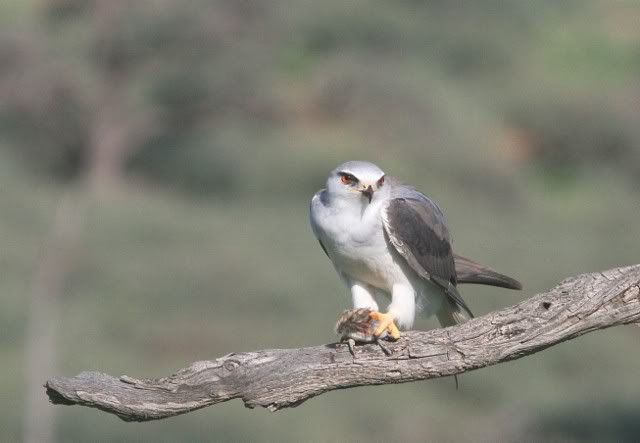 © nan
© nan
 © nan
© nan
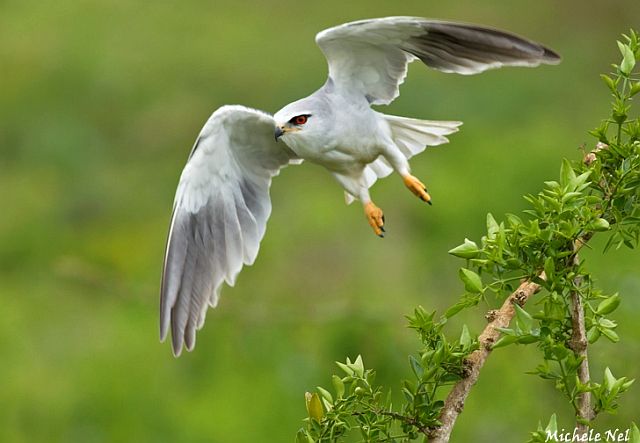 © Michele Nel
© Michele Nel
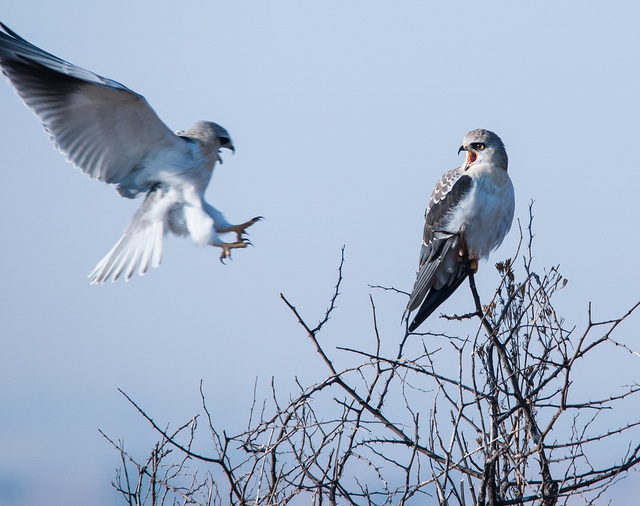 © Joan
© Joan
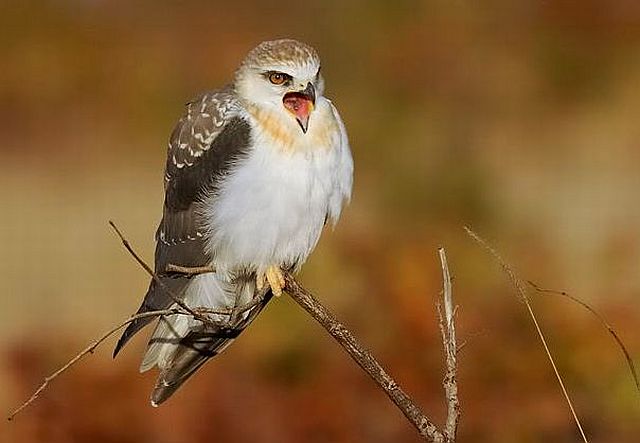 © Dewi
© Dewi
Juvenile
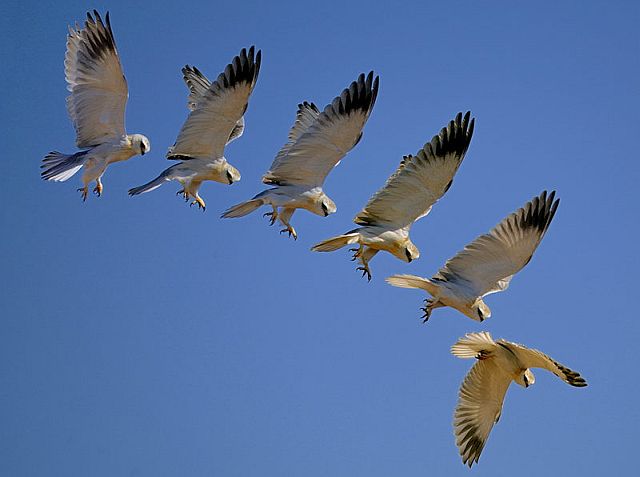 © Dewi
© Dewi
Hovering sequence
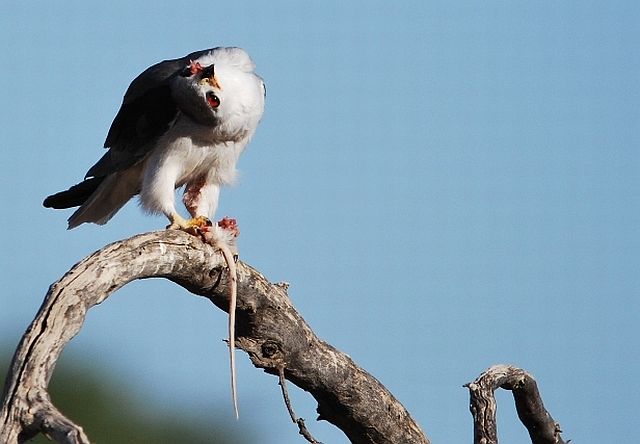 © Mel
© Mel
 © Sharifa & Duke
© Sharifa & Duke
Links:
Species text Sabap1
Sabap2
 © nan
© nan © nan
© nan © Michele Nel
© Michele Nel © Joan
© Joan © Dewi
© DewiJuvenile
 © Dewi
© DewiHovering sequence
 © Mel
© Mel © Sharifa & Duke
© Sharifa & DukeLinks:
Species text Sabap1
Sabap2
Family Accipitridae
The Accipitridae are a family of small to large birds with strongly hooked bills and variable morphology based on diet. They feed on a range of prey items from insects to medium-sized mammals, with a number feeding on carrion and a few feeding on fruit. The Accipitridae have a cosmopolitan distribution, being found on all the world's continents (except Antarctica) and a number of oceanic island groups. Some species are migratory.
Many well-known birds, such as hawks, eagles, kites, harriers and Old World vultures are included in this group.
The Accipitridae are a diverse family with a great deal of variation in size and shape. Most accipitrids exhibit sexual dimorphism in size, although unusually for birds it is the females that are larger than the males. This sexual difference in size is most pronounced in active species that hunt birds, such as Accipiter hawks, in which the size difference averages 25–50%. In a majority of species, such as generalist hunters and rodent, reptile, fish and insect hunting specialists, the dimorphism is less, usually between a 5% to 25% size difference. In the carrion-eating Old World vultures and snail eating kites, the difference is almost non-existent.
The beaks of accipitrids are strong, hooked. In some species there is a notch or 'tooth' in the upper mandible. In all accipitrids the base of the upper mandible is covered by a fleshy membrane called the cere which is usually yellow in colour. The tarsi of different species vary by diet, those of bird hunting species like sparrowhawks are long and thin, while species that hunt large mammals have much thicker, stronger ones, and snake-eagle have thick scales to protect from bites.
The plumage of the Accipitridae can be striking but rarely utilises bright colours; most birds use combinations of grey, buff and brown. Overall they tend to be paler below, which helps them seem less conspicuous when seen from below. In many species juveniles have a distinctly different plumage.
The senses of the Accipitridae are adapted to hunting (or scavenging), and in particular their vision is legendary. The sight of some hawks and eagles is up to 8 times better than that of humans. Large eyes with two fovea provide binocular vision and a "hawk eye" for movement and distance judging. In addition they have the largest pectens of any birds. The eyes are tube shaped and cannot move much in their sockets. In addition to excellent vision many species have excellent hearing, but unlike in owls sight is generally the principal sense used for hunting. Hearing may be used to locate prey hidden in vegetation, but sight is still used to catch the prey.
Accipitrids are predominately predators and most species actively hunt for their prey. Prey is usually captured and killed in the powerful talons of the raptor and then carried off to be torn apart with a hooked bill for eating or feeding to nestlings. A majority of accipitrids are opportunistic predators that will take any prey that they can kill. However, most have a preference for a certain type of prey which in harriers and the numerous buteonine hawks tends towards small mammals such as rodents. Raptors who favor small mammals usually soar or hover over openings until they detect their prey and descend upon them, although they may also watch for prey from a perch. In Accipiter hawks (the most species-rich acciptrid genus), prey is mainly comprised by other birds. Accipiter hawks usually ambush birds in dense vegetation, a dangerous hunting method that requires great agility. Most accipitrids will supplement their diet with non-putrid carrion but, of course, none specialized with this as well as the vultures.
A few species may opportunistically feed on fruit and in one species, the Palm-nut Vulture, it forms the major part of the diet. Insects are taken exclusively by around 12 species, in great numbers by 44 additional species, and opportunistically by many others. The diet of the honey-buzzards includes not only the adults and young of social insects such as wasps and bees, but the honey and combs from their nests. "Eagles" are several raptors that are not necessarily closely related but can be broadly defined by large body size and the taking of typically larger prey, including mid-sized mammals and larger birds. Most accipitrids usually hunt prey rather smaller than themselves. However, many accipitrids have been recorded as capturing and then flying with prey of equal weight or even slightly heavier than themselves in their talons, a feat that requires great physical strength. Occasionally, an eagle or other raptor that kills prey considerably heavier than itself (too heavy for the raptor to carry and fly with) and will then have to leave prey where they've killed and later return repeatedly to feed. This has the advantage of providing a surplus of food but has the disadvantage of potentially attracting scavengers or other predators which can steal the kill or even attack the feeding accipitrid. The Haliaeetus eagles prefer to prey on fish and may supplement their diets with aquatic animals other than fish. Reptiles are hunted by almost all variety of acciptrids when the opportunity arises and may even be favored over other prey by some eagles and buteonine hawks found in the tropics. Snake are the primary prey of the snake-eagles (Circaetus).
Vutures of Southern Africa
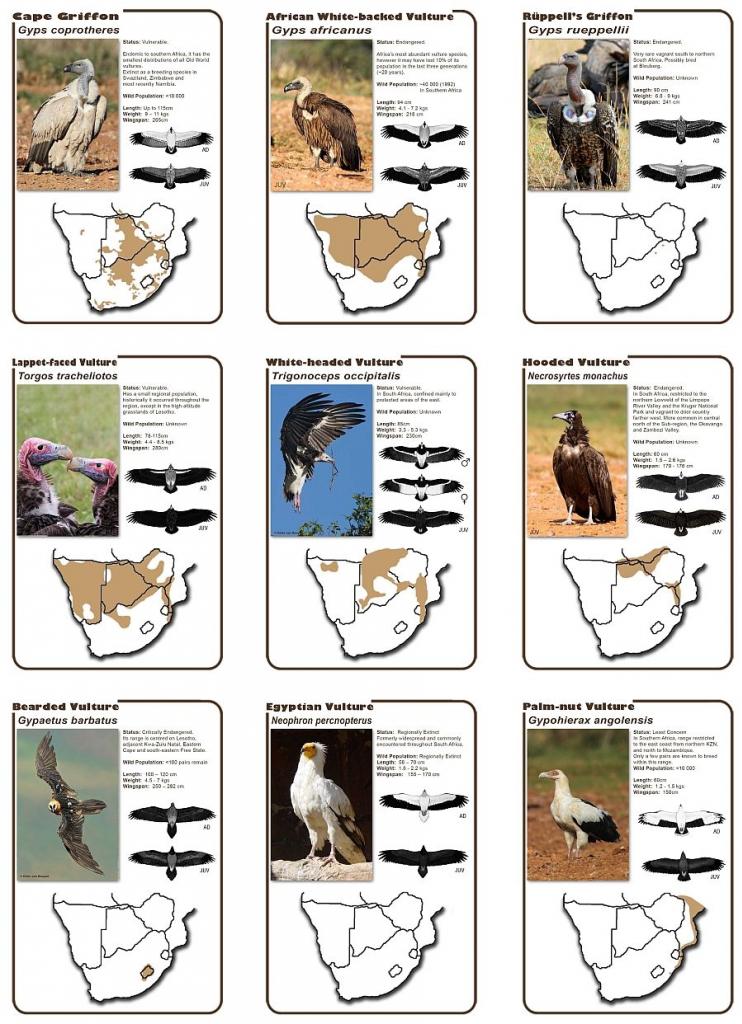
Many well-known birds, such as hawks, eagles, kites, harriers and Old World vultures are included in this group.
The Accipitridae are a diverse family with a great deal of variation in size and shape. Most accipitrids exhibit sexual dimorphism in size, although unusually for birds it is the females that are larger than the males. This sexual difference in size is most pronounced in active species that hunt birds, such as Accipiter hawks, in which the size difference averages 25–50%. In a majority of species, such as generalist hunters and rodent, reptile, fish and insect hunting specialists, the dimorphism is less, usually between a 5% to 25% size difference. In the carrion-eating Old World vultures and snail eating kites, the difference is almost non-existent.
The beaks of accipitrids are strong, hooked. In some species there is a notch or 'tooth' in the upper mandible. In all accipitrids the base of the upper mandible is covered by a fleshy membrane called the cere which is usually yellow in colour. The tarsi of different species vary by diet, those of bird hunting species like sparrowhawks are long and thin, while species that hunt large mammals have much thicker, stronger ones, and snake-eagle have thick scales to protect from bites.
The plumage of the Accipitridae can be striking but rarely utilises bright colours; most birds use combinations of grey, buff and brown. Overall they tend to be paler below, which helps them seem less conspicuous when seen from below. In many species juveniles have a distinctly different plumage.
The senses of the Accipitridae are adapted to hunting (or scavenging), and in particular their vision is legendary. The sight of some hawks and eagles is up to 8 times better than that of humans. Large eyes with two fovea provide binocular vision and a "hawk eye" for movement and distance judging. In addition they have the largest pectens of any birds. The eyes are tube shaped and cannot move much in their sockets. In addition to excellent vision many species have excellent hearing, but unlike in owls sight is generally the principal sense used for hunting. Hearing may be used to locate prey hidden in vegetation, but sight is still used to catch the prey.
Accipitrids are predominately predators and most species actively hunt for their prey. Prey is usually captured and killed in the powerful talons of the raptor and then carried off to be torn apart with a hooked bill for eating or feeding to nestlings. A majority of accipitrids are opportunistic predators that will take any prey that they can kill. However, most have a preference for a certain type of prey which in harriers and the numerous buteonine hawks tends towards small mammals such as rodents. Raptors who favor small mammals usually soar or hover over openings until they detect their prey and descend upon them, although they may also watch for prey from a perch. In Accipiter hawks (the most species-rich acciptrid genus), prey is mainly comprised by other birds. Accipiter hawks usually ambush birds in dense vegetation, a dangerous hunting method that requires great agility. Most accipitrids will supplement their diet with non-putrid carrion but, of course, none specialized with this as well as the vultures.
A few species may opportunistically feed on fruit and in one species, the Palm-nut Vulture, it forms the major part of the diet. Insects are taken exclusively by around 12 species, in great numbers by 44 additional species, and opportunistically by many others. The diet of the honey-buzzards includes not only the adults and young of social insects such as wasps and bees, but the honey and combs from their nests. "Eagles" are several raptors that are not necessarily closely related but can be broadly defined by large body size and the taking of typically larger prey, including mid-sized mammals and larger birds. Most accipitrids usually hunt prey rather smaller than themselves. However, many accipitrids have been recorded as capturing and then flying with prey of equal weight or even slightly heavier than themselves in their talons, a feat that requires great physical strength. Occasionally, an eagle or other raptor that kills prey considerably heavier than itself (too heavy for the raptor to carry and fly with) and will then have to leave prey where they've killed and later return repeatedly to feed. This has the advantage of providing a surplus of food but has the disadvantage of potentially attracting scavengers or other predators which can steal the kill or even attack the feeding accipitrid. The Haliaeetus eagles prefer to prey on fish and may supplement their diets with aquatic animals other than fish. Reptiles are hunted by almost all variety of acciptrids when the opportunity arises and may even be favored over other prey by some eagles and buteonine hawks found in the tropics. Snake are the primary prey of the snake-eagles (Circaetus).
Vutures of Southern Africa

Family Accipitridae (Kites, Hawks and Eagles) Index
Species indigenous to southern Africa:
Family Accipitridae (Kites, Hawks and Eagles)
Gypaetus barbatus Bearded Vulture 119
Neophron percnopterus Egyptian Vulture 120
Necrosyrtes monachus Hooded Vulture 121
Gyps coprotheres Cape Vulture 122
Gyps africanus White-backed Vulture 123
Torgos tracheliotos Lappet-faced Vulture 124
Trigonoceps occipitalis White-headed Vulture 125
Milvus migrans Black Kite 126
Milvus aegyptius Yellow-billed Kite 126.1
Elanus caeruleus Black-shouldered Kite 127
Aviceda cuculoides African Cuckoo-Hawk 128
Macheiramphus alcinus Bat Hawk 129
Pernis apivorus European Honey Buzzard 130
Aquila verreauxii Verreaux's Eagle 131
Aquila rapax Tawny Eagle 132
Aquila nipalensis Steppe Eagle 133
Clanga pomarina (formerly Aquila pomarina) Lesser Spotted Eagle 134
Hieraaetus wahlbergi (formerly: Aquila wahlbergi) Wahlberg's Eagle 135
Hieraaetus pennatus Booted Eagle 136
Aquila spilogaster African Hawk-Eagle 137
Hieraaetus ayresii Ayres's Hawk-Eagle 138
Lophaetus occipitalis Long-crested Eagle 139
Polemaetus bellicosus Martial Eagle 140
Stephanoaetus coronatus Crowned Eagle 141
Circaetus cinereus Brown Snake Eagle 142
Circaetus pectoralis Black-chested Snake Eagle 143
Circaetus fasciolatus Southern Banded Snake Eagle 144
Circaetus cinerascens Western Banded Snake Eagle 145
Terathopius ecaudatus Bateleur 146
Gypohierax angolensis Palm-nut Vulture 147
Haliaeetus vocifer African Fish Eagle 148
Buteo buteo vulpinus Steppe Buzzard (Common Buzzard) 149
Buteo trizonatus Forest Buzzard 150
Buteo rufinus Long-legged Buzzard 151
Buteo rufofuscus Jackal Buzzard 152
Buteo augur Augur Buzzard 153
Kaupifalco monogrammicus Lizard Buzzard 154
Accipiter rufiventris Rufous-breasted Sparrowhawk (Rufous-chested Sparrowhawk) 155
Accipiter ovampensis Ovambo Sparrowhawk 156
Accipiter minullus Little Sparrowhawk 157
Accipiter melanoleucus Black Sparrowhawk 158
Accipiter badius Shikra 159
Accipiter tachiro African Goshawk 160
Micronisus gabar Gabar Goshawk 161
Melierax canorus Pale Chanting Goshawk 162
Melierax metabates Dark Chanting Goshawk 163
Circus aeruginosus Western Marsh Harrier 164
Circus ranivorus African Marsh Harrier 165
Circus pygargus Montagu's Harrier 166
Circus macrourus Pallid Harrier 167
Circus maurus Black Harrier 168
Polyboroides typus African Harrier-Hawk 169
Gyps rueppelli Rüppell's Vulture 939
Clanga clanga (formerly Aquila clanga) Greater Spotted Eagle
Conservus faunacanus African Wild Green Eagle 1001
Milvus dewii Red Peregrine Hawk 9999
Family Accipitridae (Kites, Hawks and Eagles)
Gypaetus barbatus Bearded Vulture 119
Neophron percnopterus Egyptian Vulture 120
Necrosyrtes monachus Hooded Vulture 121
Gyps coprotheres Cape Vulture 122
Gyps africanus White-backed Vulture 123
Torgos tracheliotos Lappet-faced Vulture 124
Trigonoceps occipitalis White-headed Vulture 125
Milvus migrans Black Kite 126
Milvus aegyptius Yellow-billed Kite 126.1
Elanus caeruleus Black-shouldered Kite 127
Aviceda cuculoides African Cuckoo-Hawk 128
Macheiramphus alcinus Bat Hawk 129
Pernis apivorus European Honey Buzzard 130
Aquila verreauxii Verreaux's Eagle 131
Aquila rapax Tawny Eagle 132
Aquila nipalensis Steppe Eagle 133
Clanga pomarina (formerly Aquila pomarina) Lesser Spotted Eagle 134
Hieraaetus wahlbergi (formerly: Aquila wahlbergi) Wahlberg's Eagle 135
Hieraaetus pennatus Booted Eagle 136
Aquila spilogaster African Hawk-Eagle 137
Hieraaetus ayresii Ayres's Hawk-Eagle 138
Lophaetus occipitalis Long-crested Eagle 139
Polemaetus bellicosus Martial Eagle 140
Stephanoaetus coronatus Crowned Eagle 141
Circaetus cinereus Brown Snake Eagle 142
Circaetus pectoralis Black-chested Snake Eagle 143
Circaetus fasciolatus Southern Banded Snake Eagle 144
Circaetus cinerascens Western Banded Snake Eagle 145
Terathopius ecaudatus Bateleur 146
Gypohierax angolensis Palm-nut Vulture 147
Haliaeetus vocifer African Fish Eagle 148
Buteo buteo vulpinus Steppe Buzzard (Common Buzzard) 149
Buteo trizonatus Forest Buzzard 150
Buteo rufinus Long-legged Buzzard 151
Buteo rufofuscus Jackal Buzzard 152
Buteo augur Augur Buzzard 153
Kaupifalco monogrammicus Lizard Buzzard 154
Accipiter rufiventris Rufous-breasted Sparrowhawk (Rufous-chested Sparrowhawk) 155
Accipiter ovampensis Ovambo Sparrowhawk 156
Accipiter minullus Little Sparrowhawk 157
Accipiter melanoleucus Black Sparrowhawk 158
Accipiter badius Shikra 159
Accipiter tachiro African Goshawk 160
Micronisus gabar Gabar Goshawk 161
Melierax canorus Pale Chanting Goshawk 162
Melierax metabates Dark Chanting Goshawk 163
Circus aeruginosus Western Marsh Harrier 164
Circus ranivorus African Marsh Harrier 165
Circus pygargus Montagu's Harrier 166
Circus macrourus Pallid Harrier 167
Circus maurus Black Harrier 168
Polyboroides typus African Harrier-Hawk 169
Gyps rueppelli Rüppell's Vulture 939
Clanga clanga (formerly Aquila clanga) Greater Spotted Eagle
Conservus faunacanus African Wild Green Eagle 1001
Milvus dewii Red Peregrine Hawk 9999
- Flutterby
- Posts: 44150
- Joined: Sat May 19, 2012 12:28 pm
- Country: South Africa
- Location: Gauteng, South Africa
- Contact:
African Harrier-hawk
169. African Harrier-hawk (formerly known as Gymnogene) Polyboroides typus (Kaalwangvalk)
Order: Accipitriformes. Family: Accipitridae
Description
Largest grey hawk in the region. It has a distinctive small, pointed head, with a patch of naked yellow skin on the face which flushes pink or reddish during social interactions when the bird is excited. It has a crest of feathers, which may be raised or lowered. The plumage is mainly grey, with neat black and white barring on the abdomen and thighs. The wings are long and rounded, with distinct, broad black ends to the flight feathers, and the tail is black and relatively long, with a clear white or grey central band. It has long thin yellow legs.
Sexes are similar, though the female may be slightly larger than the male, while juveniles have brown plumage, blackish facial skin, a brown tail with four darker brown bars, and variable amounts of whitish, reddish-brown or dark bars or streaks on the abdomen. Adult plumage is not attained until about the third year.
Distribution
Occurs across much of sub-Saharan Africa; in southern Africa it is locally common in Zimbabwe, Mozambique, northern and eastern Botswana, northern Namibia (including the Caprivi Strip) and eastern and southern South Africa.
Habitat
Open country, avoiding desert and well-wooded areas.
Diet
The African Harrier-hawk is a specialist nestling raider and appears universally hated by other birds. It mainly eats birds and their eggs, reptiles and small mammals, using a wide variety of foraging techniques. It specialises in using its long legs to extract food from crevices and cavities, such as in the tree canopy or the ground, often stealing eggs and chicks from weaver nests, or the more easily accessible nests of other birds (without entrance tunnels). It also hunts by soaring high in the sky and rapidly descending once it has spotted prey, sometimes scavenging for roadkills and raiding nests in suburban gardens.
Breeding
Usually a monogamous, highly territorial solitary nester. The nest is built by both sexes in about 30 days, consisting of a platform about 75cm wide and 20cm deep, made of sticks and thickly lined with green leaves. It is typically placed in the upper branches of a tree, in a cave or between the base of a bush and a cliff; it also uses the nests of other birds, such as Black Sparrowhawk and Martial Eagle. Egg-laying season is from August-December, peaking from September-November. The female lays 1-3 eggs which are mainly incubated by the female for about 35-36 days, while the male provides food to her at the nest. The chicks are fed by the male and brooded constantly by the female for the first week of their lives, after which she remains near the nest to protect them. The older chick sometimes kills its younger sibling, even if it is fully fed and supervised by an adult. The young leave the nest at about 45-55 days old, remaining partially dependent on their parents for at least another 10 days.
Call
The African Harrier-hawk is a fairly silent bird, but in the breeding season gives a long, plaintive suuu-eeee-ooo call, as well as a high hweep-hweek-hweep near the nest, when breeding. Listen to Bird Call.
Status
Common to scarce resident.
Order: Accipitriformes. Family: Accipitridae
Description
Largest grey hawk in the region. It has a distinctive small, pointed head, with a patch of naked yellow skin on the face which flushes pink or reddish during social interactions when the bird is excited. It has a crest of feathers, which may be raised or lowered. The plumage is mainly grey, with neat black and white barring on the abdomen and thighs. The wings are long and rounded, with distinct, broad black ends to the flight feathers, and the tail is black and relatively long, with a clear white or grey central band. It has long thin yellow legs.
Sexes are similar, though the female may be slightly larger than the male, while juveniles have brown plumage, blackish facial skin, a brown tail with four darker brown bars, and variable amounts of whitish, reddish-brown or dark bars or streaks on the abdomen. Adult plumage is not attained until about the third year.
Distribution
Occurs across much of sub-Saharan Africa; in southern Africa it is locally common in Zimbabwe, Mozambique, northern and eastern Botswana, northern Namibia (including the Caprivi Strip) and eastern and southern South Africa.
Habitat
Open country, avoiding desert and well-wooded areas.
Diet
The African Harrier-hawk is a specialist nestling raider and appears universally hated by other birds. It mainly eats birds and their eggs, reptiles and small mammals, using a wide variety of foraging techniques. It specialises in using its long legs to extract food from crevices and cavities, such as in the tree canopy or the ground, often stealing eggs and chicks from weaver nests, or the more easily accessible nests of other birds (without entrance tunnels). It also hunts by soaring high in the sky and rapidly descending once it has spotted prey, sometimes scavenging for roadkills and raiding nests in suburban gardens.
Breeding
Usually a monogamous, highly territorial solitary nester. The nest is built by both sexes in about 30 days, consisting of a platform about 75cm wide and 20cm deep, made of sticks and thickly lined with green leaves. It is typically placed in the upper branches of a tree, in a cave or between the base of a bush and a cliff; it also uses the nests of other birds, such as Black Sparrowhawk and Martial Eagle. Egg-laying season is from August-December, peaking from September-November. The female lays 1-3 eggs which are mainly incubated by the female for about 35-36 days, while the male provides food to her at the nest. The chicks are fed by the male and brooded constantly by the female for the first week of their lives, after which she remains near the nest to protect them. The older chick sometimes kills its younger sibling, even if it is fully fed and supervised by an adult. The young leave the nest at about 45-55 days old, remaining partially dependent on their parents for at least another 10 days.
Call
The African Harrier-hawk is a fairly silent bird, but in the breeding season gives a long, plaintive suuu-eeee-ooo call, as well as a high hweep-hweek-hweep near the nest, when breeding. Listen to Bird Call.
Status
Common to scarce resident.
- Flutterby
- Posts: 44150
- Joined: Sat May 19, 2012 12:28 pm
- Country: South Africa
- Location: Gauteng, South Africa
- Contact:
African Harrier-hawk Photos
169. African Harrier-hawk (formerly known as Gymnogene) Polyboroides typus
 © Flutterby
© Flutterby
 © Bushcraft
© Bushcraft
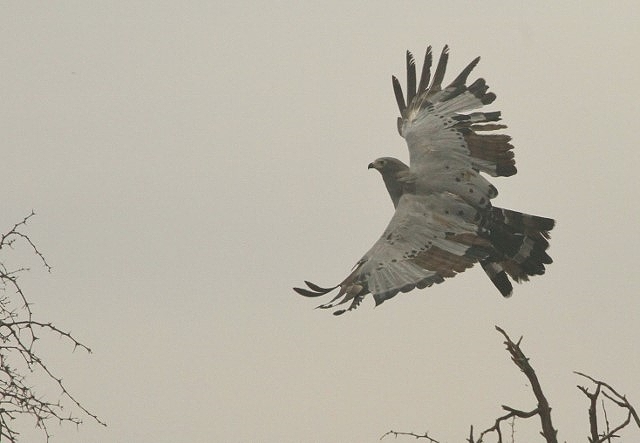 © nan
© nan
 © Dewi
© Dewi
Juvenile, Kruger National Park, Kanniedood Dam road
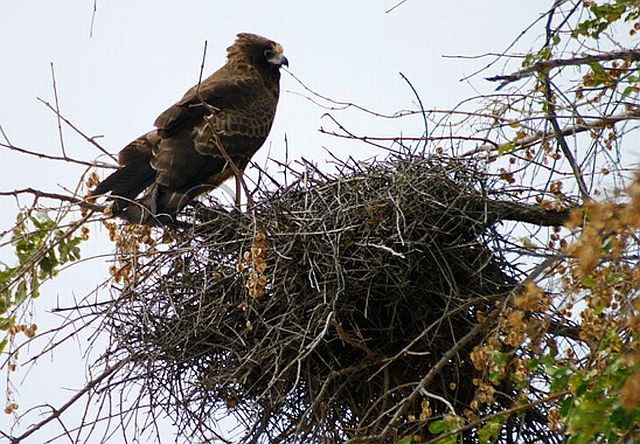 © Sprocky
© Sprocky
 © nan
© nan
Etosha
Links:
Species text Sabap1
Sabap2
Global Raptor Information Network
Oiseaux net: http://www.oiseaux-birds.com/card-afric ... -hawk.html
 © Flutterby
© Flutterby © Bushcraft
© Bushcraft © nan
© nan © Dewi
© DewiJuvenile, Kruger National Park, Kanniedood Dam road
 © Sprocky
© Sprocky © nan
© nanEtosha
Links:
Species text Sabap1
Sabap2
Global Raptor Information Network
Oiseaux net: http://www.oiseaux-birds.com/card-afric ... -hawk.html
Palm-nut Vulture
147. Palm-nut Vulture Gypohierax angolensis (Witaasvoel)
Order: Accipitriformes. Family: Accipitridae
Description
60 cm. A small vulture with black & white plumage. Males slightly smaller than females. Head and neck is dull white or creamy white. Scapulars, secondaries and greater upper wing coverts black. Underparts dull white or creamy white. Bill horn-coloured, cere yellow. Eyes yellow, sometimes deep orange. Large area of bare skin around eyes, and below bill, pink or orange-pink. Legs and feet flesh-coloured, talons large and black.
Juveniles are brown with pale yellow rump.
Similar species: Adults likely to be confused only with adult Egyptian Vulture which is an extreme vagrant to the region. Juveniles are most likely to be confused with juvenile or immature African Fish-eagle or Hooded Vulture, but note bill size compared to Hooded and amount of white seen on African Fish-eagle.
Distribution
Sub-Saharan Africa, from Gambia to the DRC, with isolated populations further east and south. In southern Africa it is uncommon and localised in coastal and northern Mozambique, and KwaZulu-Natal, while more scarce in the Caprivi Strip (Namibia), northern Botswana, Limpopo Province and the Eastern and Western Cape.
Habitat
Its distribution is strongly linked to that of the Kosi palm (Raphia australis) which it is dependent on for food and nest sites; it may also occupy edges of freshwater lakes, estuaries and swamps or along heavily forested rivers.
Diet
It is mainly frugivorous, largely feeding on the fruit of the Kosi palm (Raphia australis) supplemented with small mammals, frogs, fish and invertebrates. When feeding on palm fruit it breaks off an individual fruit from the cluster and takes it to a branch or palm frond, where it flicks off the scales with its bill so that it can feed on the flesh; once finished it drops the kernel to the ground and returns to the cluster for more.
Breeding
A monogamous solitary nester, it strongly defends its territory against other Palm-nut Vultures and raptors, chasing them away. The nest is built by both sexes, consisting of a large platform of sticks lined with dry grass, other plant fibres and dung. It is typically placed in the upper fronds of Raphia palms, although it may rarely use a Eucalyptus tree instead. Egg-laying season is from August-September. The female lays one egg, which is mainly incubated by the female for about 42-47 days. The chick is fed by both parents on a diet of mainly animal food at first, but in the last month before it leaves the nest it is weaned onto palm fruit, until at about 85-91 days old it leaves the nest and is capable of collect fruit for itself. It remains in the vicinity of the nest for about three more months, before becoming fully independent.
Status
Rare and localised.
Order: Accipitriformes. Family: Accipitridae
Description
60 cm. A small vulture with black & white plumage. Males slightly smaller than females. Head and neck is dull white or creamy white. Scapulars, secondaries and greater upper wing coverts black. Underparts dull white or creamy white. Bill horn-coloured, cere yellow. Eyes yellow, sometimes deep orange. Large area of bare skin around eyes, and below bill, pink or orange-pink. Legs and feet flesh-coloured, talons large and black.
Juveniles are brown with pale yellow rump.
Similar species: Adults likely to be confused only with adult Egyptian Vulture which is an extreme vagrant to the region. Juveniles are most likely to be confused with juvenile or immature African Fish-eagle or Hooded Vulture, but note bill size compared to Hooded and amount of white seen on African Fish-eagle.
Distribution
Sub-Saharan Africa, from Gambia to the DRC, with isolated populations further east and south. In southern Africa it is uncommon and localised in coastal and northern Mozambique, and KwaZulu-Natal, while more scarce in the Caprivi Strip (Namibia), northern Botswana, Limpopo Province and the Eastern and Western Cape.
Habitat
Its distribution is strongly linked to that of the Kosi palm (Raphia australis) which it is dependent on for food and nest sites; it may also occupy edges of freshwater lakes, estuaries and swamps or along heavily forested rivers.
Diet
It is mainly frugivorous, largely feeding on the fruit of the Kosi palm (Raphia australis) supplemented with small mammals, frogs, fish and invertebrates. When feeding on palm fruit it breaks off an individual fruit from the cluster and takes it to a branch or palm frond, where it flicks off the scales with its bill so that it can feed on the flesh; once finished it drops the kernel to the ground and returns to the cluster for more.
Breeding
A monogamous solitary nester, it strongly defends its territory against other Palm-nut Vultures and raptors, chasing them away. The nest is built by both sexes, consisting of a large platform of sticks lined with dry grass, other plant fibres and dung. It is typically placed in the upper fronds of Raphia palms, although it may rarely use a Eucalyptus tree instead. Egg-laying season is from August-September. The female lays one egg, which is mainly incubated by the female for about 42-47 days. The chick is fed by both parents on a diet of mainly animal food at first, but in the last month before it leaves the nest it is weaned onto palm fruit, until at about 85-91 days old it leaves the nest and is capable of collect fruit for itself. It remains in the vicinity of the nest for about three more months, before becoming fully independent.
Status
Rare and localised.
Palm-nut Vulture Photos
147. Palm-nut Vulture Gypohierax angolensis
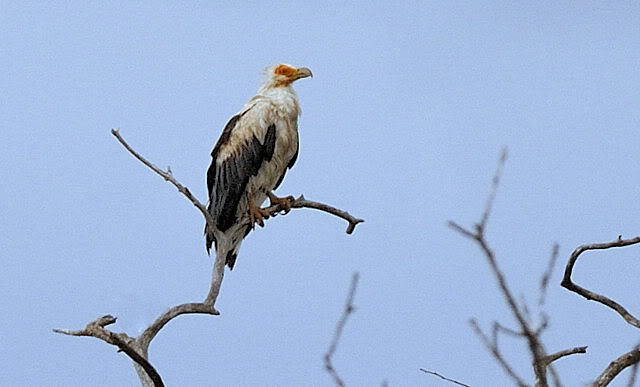 © Dewi
© Dewi
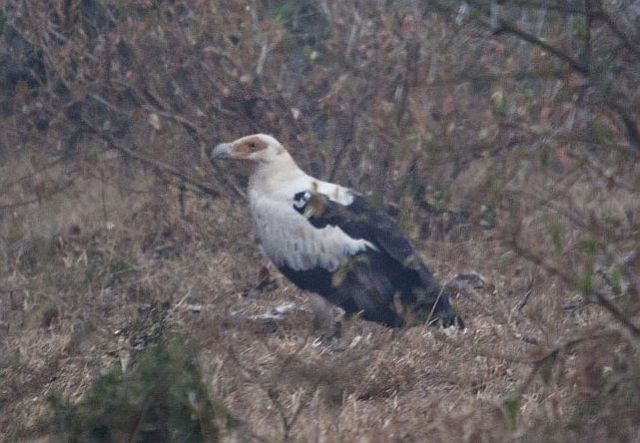 © PRWIN
© PRWIN
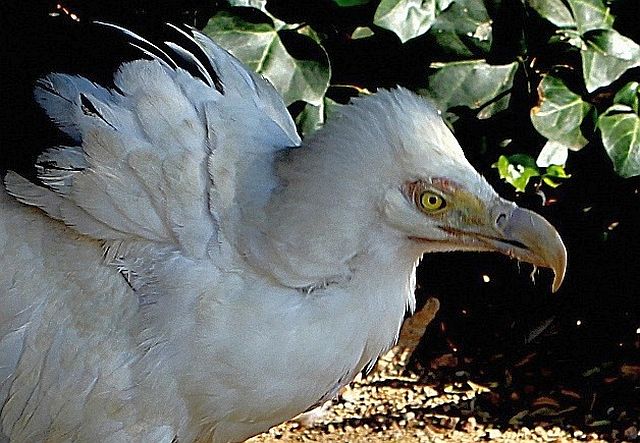 © Amoli
© Amoli
 © PRWIN
© PRWIN
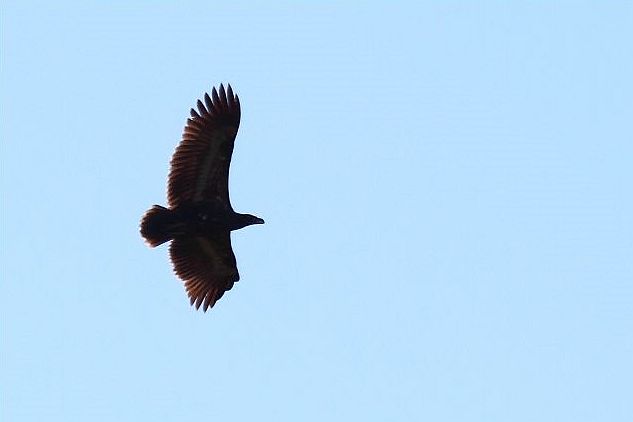 © Duke
© Duke
Juvenile, Mtunzini Raphia Palm Monument, KwaZulu-Natal
Links:
Species text Sabap1
Sabap2: http://sabap2.adu.org.za/spp_summary.ph ... §ion=3
Global Raptor Information Network
David Allan. A Photographic Guide to Birds of Prey of Southern, Central and East Africa
Oiseaux net: http://www.oiseaux-birds.com/card-palm-nut-vulture.html
 © Dewi
© Dewi © PRWIN
© PRWIN © Amoli
© Amoli © PRWIN
© PRWIN © Duke
© DukeJuvenile, Mtunzini Raphia Palm Monument, KwaZulu-Natal
Links:
Species text Sabap1
Sabap2: http://sabap2.adu.org.za/spp_summary.ph ... §ion=3
Global Raptor Information Network
David Allan. A Photographic Guide to Birds of Prey of Southern, Central and East Africa
Oiseaux net: http://www.oiseaux-birds.com/card-palm-nut-vulture.html


